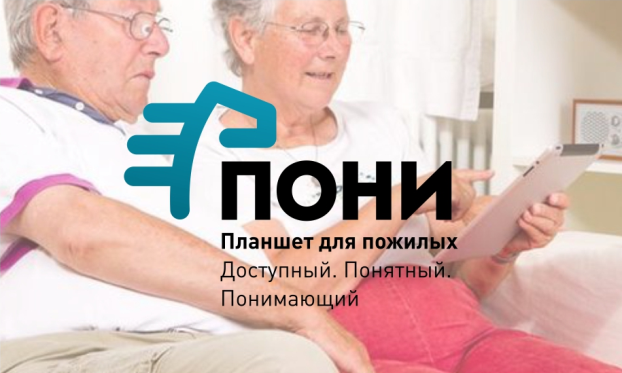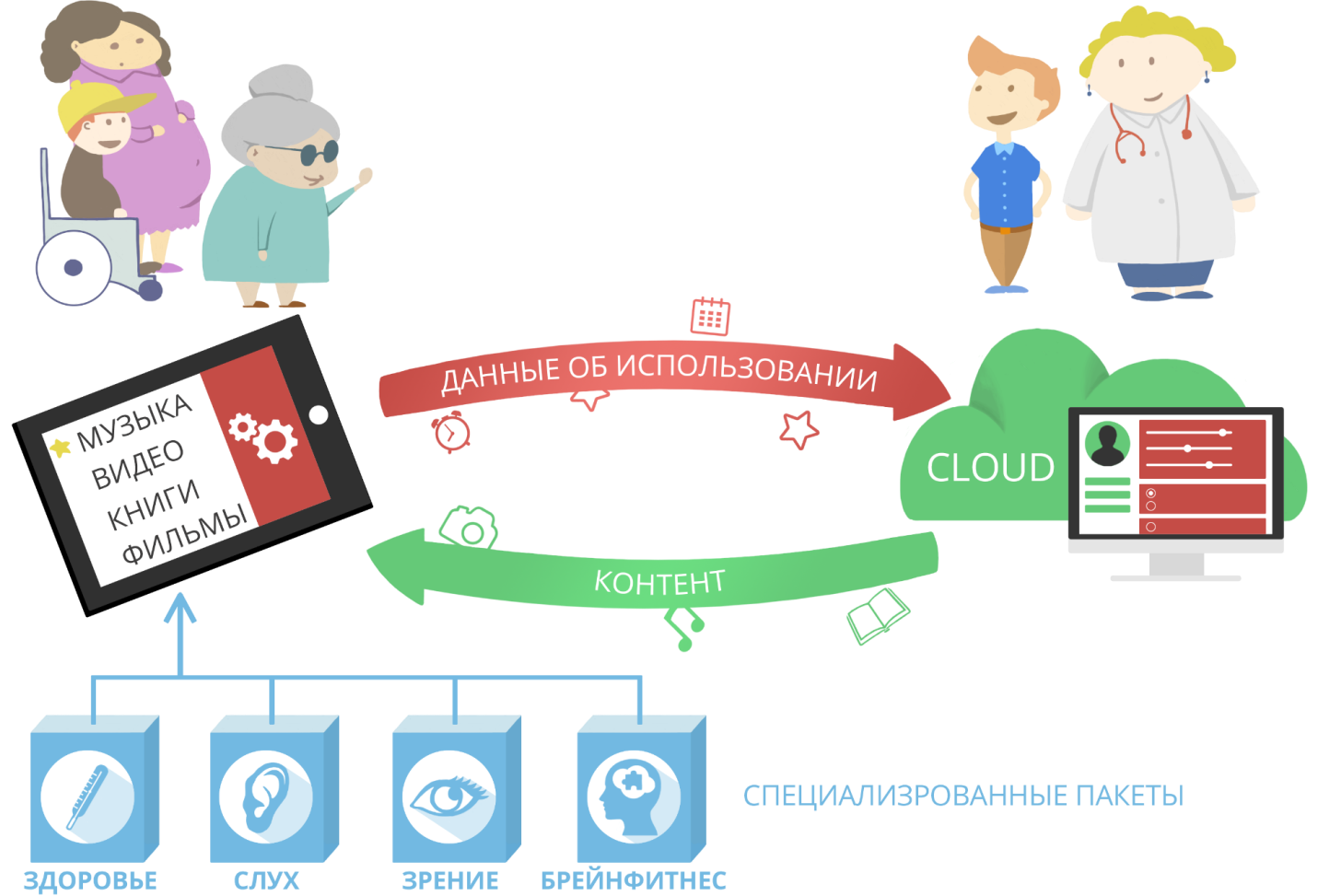Tablet for the elderly. How the project has evolved over the past two years

In previous posts I wrote about an acute problem: people of old age are excluded from the IT world. Let this world be virtual, but it can somehow compensate for the losses of the real world: forced exclusion from the usual active life, limited communication, the loss of the usual connections, etc.
We figured out how to solve this problem, and our project aroused great interest. Now I will talk about how over the past two years the scale of the project has grown, about what interest the Russian and international community has shown in it. To reach the goal at hand. Welcome under cat.
FROM IDEA TO CONCEPT
')
In terms of the project itself, its scale has increased significantly. We started with the idea of simple tablet software, easy to learn and use by older people. Over the past two years, we were able to communicate with very interesting specialists and enthusiasts from related areas, and we saw that the project needed to be expanded.
First, we are now talking about designing a comfortable IT environment:
- elderly people need convenient and easy-to-learn means of communicating with family and friends;
- you will need tools for remote control of tablets by your relatives and means for remotely replenishing tablets with new photos, movies, books, etc .;
- New interfaces for browsers, social networks, popular applications that will be comfortable for the elderly and easy to learn will radically expand the capabilities of old people in the use of modern IT applications and services.
Secondly, we realized that in the topic “IT for the elderly” it is impossible to bypass issues related to health monitoring. Therefore, we have added modules to the basic “entertainment” modules of the projected software, which, in conjunction with the connected devices, would enable monitoring of health indicators and sending information to interested persons - relatives and health workers.
Thirdly, it became clear that due to the customizability of modules, one can naturally significantly expand the audience of users. Our software is designed to circumvent the cognitive limitations of older users, but such limitations are inherent not only to older people, but also to people suffering from various kinds of cognitive impairments - cerebral palsy, Down syndrome, dyslexia, autism, etc.
Finally, we were happy to find that by replacing part of the modules (and the modular structure of the projected software allows it), we will be able to expand the scope of our software's use to the education of special children: it turned out that the scope of teaching children with hearing and visual impairments, as well as with cognitive impairment, virtually no IT coverage.
Thus, the target comfortable IT environment for the above vulnerable groups looks like this:

It is important to note that interested persons are not only older people, but also their children and grandchildren, acquaintances who care for the elderly and help them.
HOW WE PROMOTED OUR IDEA
Over the past year we have shown the project at several events:
1. In June 2014, we successfully presented the “Tablet for Older People” project at the “Intellect-Center” meeting, which was organized by the “Resource Bank for the Development of Social Entrepreneurship” and supported by the Committee on Social Entrepreneurship and Corporate Social Responsibility “Ops of Russia” .
2. In July 2014, the final of the contest “MTS Telecommunication - Idea 2014” was held at HSE. According to the results of the competition, the All-Russian organization Opora Rossii and AFK Sistema called our project “Tablet for seniors” the winner in the nomination “The best socially-oriented projects in the field of telecommunications”.
3. At the end of 2014, our project was accepted for examination by the Agency for Strategic Initiatives (ASI). The agency presented us to the Technology of Opportunities Development Center for Social Innovations , the joint work with which has seriously expanded our horizons.
4. In April 2015, a meeting of the expert council of the Technology Opportunities program at the Moscow State Technical University named after Bauman, on which the decision was made to approve our project “Tablet for Persons with Disabilities and Senior Citizens” as a participant in the program of support to projects in the field of problem solving of people with disabilities “Technology of Opportunities”.
5. In May 2015, we successfully presented the project at the M-Enabling Russia conference in Moscow.
At all events, our performances aroused genuine interest and were accompanied by many interested discussions.
You can follow the project's events in social networks - publications about the project are marked with the hashtag # tablet for the elderly.
THIS TIME ON THE PLANET EARTH HAS NOT CHANGED ANYTHING
Over the past two years, the situation with the possible analogues of our solution has almost not changed in the world: in the West there is a trend “digital technologies for the elderly”, but as part of this trend, products and services are mainly being released to control the activity of the elderly. And even in Russia there was no trend, and no. There is no trend, but there are enthusiasts with excellent projects: “Networks are all ages submissive” from MTS, projects “Baba-Deda” , “Care System” , etc. The most famous is probably the “Button of Life” project .
An international event of separate mention took place at the end of April 2015, when IBM and Apple announced the start of a joint program with Japan Post (Japan Post) on supplying Japanese pensioners with iPads with special software.
World giants have declared that in this way they will radically improve the quality of life of millions. According to them, they will not stop at Japan, and this is only the first step in caring for the elderly around the world.
They are not going to move quickly, they will start with the implementation on the iPad of the existing automated control service in Japan for those who live alone: a service that allows you to send a “I'm fine” signal.
Details about future plans and the value of the product the company does not disclose.
Such an initiative by IBM and Apple is excellent news for us: the participation of these giants confirms the importance of the topic, and at the same time we started earlier and are preparing a cheaper product for a much larger market.
WHERE ARE WE NOW
We want to provide vulnerable populations with the opportunity to use the new expanded reality.
We have the experience, knowledge and understanding, we have the working resources and the necessary infrastructure. To date, a study has been carried out, TK has been prepared and a prototype of our application has been released. The next step should be the release of industrial design, which could be put into production and distribute. We are looking for financing for the production of industrial design and market entry.
We need funding, highly specialized knowledge and, very importantly, partners.
By partners, I understand both financial partners and technological partners - companies that manufacture similar products, companies with which we, by combining our knowledge and efforts, could create something new.
In recent months, ASI and Technology Opportunities have helped us a lot in holding meetings with potential partners. In particular, with their support, we posted the first version of our project on the crowdfunding portal Planeta.ru.
Separately, I would like to say about the state. Generally speaking, it is the state that becomes one of the main beneficiaries. Indeed, as we already know, the population is aging, and old age is the infirmities and diseases that need to be treated, and money is needed for treatment. Thus, the longer an aging person stays healthy and satisfied with life, the more profitable the state.
Other things being equal, patients with problems of the brain and nervous system, such as dementia, Alzheimer's disease, etc., belong to the most expensive groups of patients, because such people need almost constant supervision and care. Thus, by helping to preserve the health and activity of the brain of the elderly, the state saves huge amounts of money. The key to maintaining brain activity is brain fitness.
In our concept of adaptive, comfortable IT environment, brain fitness is the foundation because active and interested use of IT devices and services is a constant brain training.
If you recall the IBM and Apple experience I mentioned in Japan, you should pay attention to the fact that these two world giants operate through the Japan Post Group, which is Japan’s largest life and health insurance company.
In our opinion, in Russia our project should be of interest to the Ministry of Health, the Ministry of Labor and the Ministry of Communications and Mass Media. Through the Ministry of Communications and Mass Media, in particular, it would be possible for older citizens to access the Gosuslug portal: the portal would greatly help the elderly to conduct their business with the state, but for this, its interfaces need to be changed so that elderly people can use it.
WE GO AHEAD
So, there is a clearly defined goal, there are millions of people for whom the success of the project will mean a serious improvement in the quality of life, there are we - the specialists who have invented all this and are ready to bring it to life. Responsible representatives of many well-known companies and organizations have repeatedly expressed genuine interest in the project.
Oddly enough, the obviousness and mass character of the problem have become obstacles in our path. It was not possible to connect to the state programs (the reason is formal - we are not NPOs), and for the departments of social responsibility of even large corporations, this topic seems to be unaccustomed to its scale. The investors we approached are cautious about entering the “IT for the elderly” market - a huge, promising, but not yet tested. Now we have high hopes for crowdfunding.
We are sure that this topic is very important for many. Send any ideas, tips, contacts - everything that would help us continue to actively develop the project, take the first real steps towards creating a comfortable IT environment for the elderly.
Source: https://habr.com/ru/post/268707/
All Articles